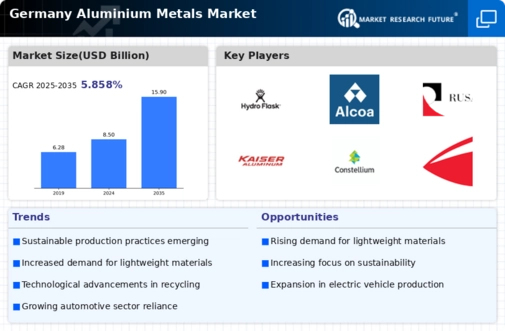The aluminium metals market in Germany exhibits a competitive landscape characterized by a blend of established players and emerging innovators. Key growth drivers include the increasing demand for lightweight materials in the automotive and aerospace sectors, alongside a heightened focus on sustainability and recycling. Major companies such as Novelis Inc. (US), Hydro Aluminium (NO), and Trimet Aluminium SE (DE) are strategically positioned to leverage these trends. Novelis Inc. (US) emphasizes its commitment to sustainability through extensive recycling initiatives, while Hydro Aluminium (NO) focuses on digital transformation to enhance operational efficiency. Trimet Aluminium SE (DE) is actively pursuing regional expansion to strengthen its market presence, collectively shaping a competitive environment that prioritizes innovation and sustainability.
In terms of business tactics, companies are increasingly localizing manufacturing to reduce lead times and optimize supply chains. The market structure appears moderately fragmented, with several key players exerting considerable influence. This fragmentation allows for a diverse range of strategies, as companies seek to differentiate themselves through unique value propositions. The collective influence of these players fosters a dynamic environment where agility and responsiveness to market demands are paramount.
In November 2025, Novelis Inc. (US) announced a significant investment of $150 million to expand its recycling capabilities in Germany. This strategic move underscores the company's commitment to sustainability and positions it to meet the growing demand for recycled aluminium. By enhancing its recycling infrastructure, Novelis Inc. (US) not only strengthens its supply chain but also aligns with the increasing regulatory pressures for sustainable practices in the aluminium sector.
In October 2025, Hydro Aluminium (NO) launched a new digital platform aimed at optimizing production processes and improving customer engagement. This initiative reflects the company's focus on digital transformation, which is likely to enhance operational efficiency and reduce costs. By integrating advanced technologies into its operations, Hydro Aluminium (NO) positions itself as a leader in innovation within the aluminium metals market.
In September 2025, Trimet Aluminium SE (DE) entered into a strategic partnership with a local automotive manufacturer to supply lightweight aluminium components. This collaboration not only expands Trimet's market reach but also aligns with the automotive industry's shift towards more sustainable materials. The partnership is expected to drive innovation in product development and enhance Trimet's competitive positioning in the market.
As of December 2025, current competitive trends indicate a strong emphasis on digitalization, sustainability, and the integration of AI technologies. Strategic alliances are increasingly shaping the landscape, enabling companies to pool resources and expertise. The shift from price-based competition to a focus on innovation, technology, and supply chain reliability is evident. Moving forward, competitive differentiation will likely hinge on the ability to adapt to these trends, with companies that prioritize sustainability and technological advancement poised to lead the market.




















Leave a Comment